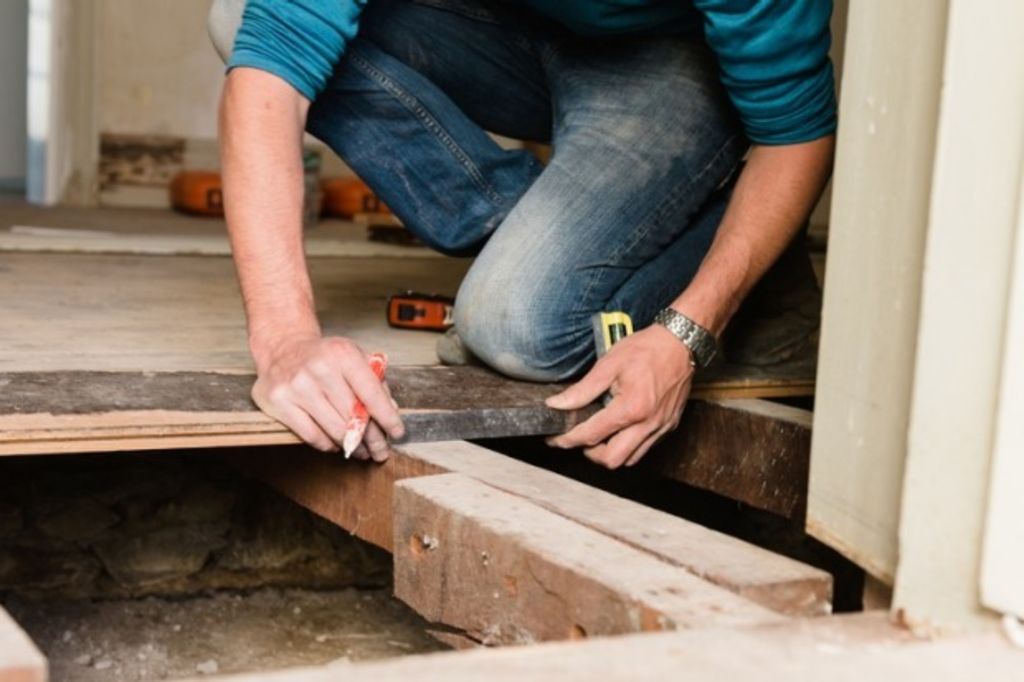7 DIY tips to know before you start renovating

There are two types of people: those who decide to improve their home and call up a renovation company and those who grab the toolbox and dig in.
If you’re the latter, a DIY aficionado, you’re going to be on a steep road to learning a lot about renovating.
1. It takes double the time and money calculated
 Thought you only needed one tin? Think again. Photo: Paul Jones
Thought you only needed one tin? Think again. Photo: Paul Jones
Take a simple home improvement task, such as painting a room. Initially, you’re considering a tin of beige paint and a couple of brushes. Then you’re being told that because of the heinous shade of red your bedroom has been for the past five years, you’re going to need an undercoat and extra brushes. You’re also going to have to paint two coats of each.
Tasks that initially seemed simple – getting a rug that matches the colour of the newly painted walls – might actually not be that easy after all. Chances are you’ve picked a colour that the company you had in mind doesn’t make into standard carpets and you’ll have to order in a bespoke piece.
Extrapolate this to the majority of “small” DIY fix ups you had planned and you’ll get the picture. The initial job looks simple, but digging beneath the surface reveals that a quick couple of hours’ fix-up is now an entire weekend’s worth of work. Do yourself a favour and over-estimate your costs and the length of time to ensure you have room to breathe.
2. You’re not actually a professional
 It’s not always going to be quite as straightforward a job as you’d hoped. Photo: Anna-Lisa Backlund
It’s not always going to be quite as straightforward a job as you’d hoped. Photo: Anna-Lisa Backlund
If you think you’re a relatively intelligent person, then try your hand at a bit of plumbing. You’ll soon be questioning your sanity, your depth perception and why those pipes don’t fit when everything on the packet promises they will.
You might even want to consider tiling the bathroom floor yourself. Welcome to the world of minimum slope standards and waterproofing that will have even the most optimistic scratching their heads.
Sometimes, it’s just you and sometimes it’s just plain tricky.
If you haven’t been an apprentice and learned the trade, then don’t be surprised when you find yourself tearing your hair out. If it was easy to do, then there wouldn’t be a thriving market for tradies and other experts who do this sort of thing full-time.
3. Planning is everything
 Don’t lift that hammer until you’ve written down a plan. Photo: Thinkstock
Don’t lift that hammer until you’ve written down a plan. Photo: Thinkstock
If you know upfront what you’re trying to achieve and what is required to achieve it, then you’ll be miles ahead of most DIYers. Enthusiasm can drive a project some of the way, but without setting the groundwork it will take some sort of miracle for the renovation to be a success.
While one of the first steps – after a Pinterest vision board – is to start gutting out a room and taking the sledgehammer to it, it might not be the wisest way to spend your time.
Writing out lists of what needs to be done, and having a firm grasp on the extent of the project and the costs, as well as a schedule, will put you in the best possible position to succeed. Regardless of how big or small the improvement, a little bit of thought ahead of time goes a long way.
4. More hands make light work
 Getting friends and family involved can save on labour, but it brings with it a whole host of other complications. Photo: istock
Getting friends and family involved can save on labour, but it brings with it a whole host of other complications. Photo: istock
Everyone has their limitations and if you’re renovating alone, particularly without expertise, it’s going to be a struggle. Know your strengths and capacity and what you might need help with. Ensure you have enough people and skills among you to adequately finish the project in the timeframe you have in mind.
On the other hand, too many helpers can mean arguments, clashes and conflicts so you need to pick your team of willing volunteers very carefully, if you have the luxury.
If you’re relying on the charity of family and friends, be prepared to grit your teeth when you aren’t happy with how something has been done and to learn how to tactfully suggest they do it another way. They’re volunteers, not slaves, so a little bit of effort on your part to make the day more fun will go a long way – a thank you card and some home cooking will also do wonders.
5. You will fail
 You’ll likely stuff it up, but each failure is a lesson. Photo: Jessica Hromas
You’ll likely stuff it up, but each failure is a lesson. Photo: Jessica Hromas
You may have a very clear vision of what you want your home office to look like. But a shelving disaster or a change of heart about where to put the cupboards, and a couple of weeks later it’s still not quite what you had in mind.
Don’t be disheartened – it happens to the best of unskilled DIYers. Sometimes what you want just won’t happen, sometimes it couldn’t even be achieved by the experts. Hopefully there will be more wins than losses, but don’t count on everything going your way.
Outsourcing isn’t a bad thing – if you’ve failed at it, dust yourself down and pick up the phone. You might also want to ensure you adjust your expectations accordingly for the next time you pick up the drill.
6. Cheap isn’t always good
 Pinching the pennies too much isn’t always a recipe for success. Photo: ERIN JONASSON
Pinching the pennies too much isn’t always a recipe for success. Photo: ERIN JONASSON
Cheap can be an absolute bargain. And sometimes, cheap is just cheap.
You need to become an expert at knowing the difference between the two. If you’re on a budget you’ll need to decide what you are willing to compromise on, what you’d be happy to wait for and what will just require a big initial spend.
Most DIYers and home renovators can save themselves money by being aware of how much things normally cost. Paying attention at furniture stores, whitegoods stores and online for building materials will ensure you’re in prime position to snap up a bargain when it does happen and to query something if it seems too good to be true.
7. Nothing is “standard”
 It’s time to get well acquainted with a tape measure.
It’s time to get well acquainted with a tape measure.
It’s time to measure, Google and work out exactly how to describe what it is that you are trying to do.
You might think your room is “standard” or “average” and ask for that amount in paint. Most of the time you’ll be told there’s no such thing and sent home to re-assess.
A “microwave nook” in the kitchen might not necessarily fit your new microwave. Take measurements or you’ll end up with something that doesn’t fit and you’ll have to start the process all over again.
We recommend
States
Capital Cities
Capital Cities - Rentals
Popular Areas
Allhomes
More
- © 2025, CoStar Group Inc.







